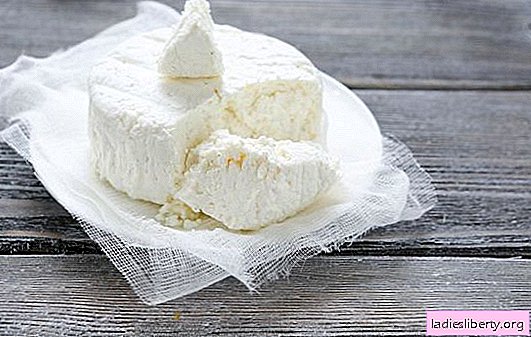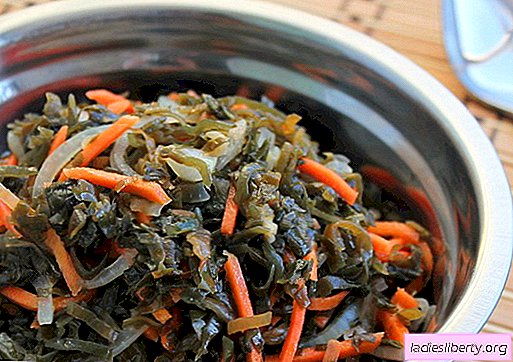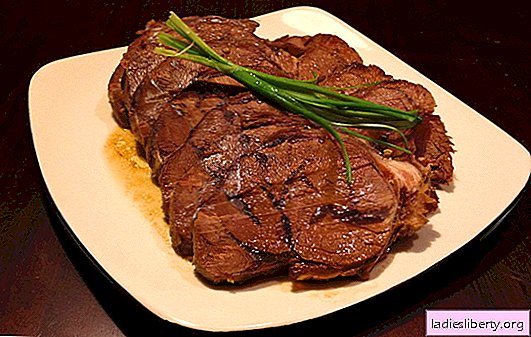
Curd is so simple and easy to cook. It is also a great way to identify stagnant milk. If cottage cheese is not used, then cheese can be made from it. Or completely switch to the manufacture of homemade dairy products. But why are they not always obtained?
No quality - no result
The assortment of dairy products is impressive, but the composition is even more surprising. Instead of milk and cream, you can see vegetable fats, preservatives, milk fat substitutes, and milk reconstituted from dry concentrate in it. In general, you can still continue, but the problem is obvious. If you do not take milk, then you will not get cottage cheese.
When buying products, it is important not to save, but to carefully look at the composition. Vegetable milk is not curdled, has completely different properties.
If the cottage cheese comes out of it, then the cheese certainly will not work.
Why cottage cheese does not move away from whey
It happens that your milk is either bought in a safe place, but the cottage cheese does not separate from the whey, it remains white, the yield of the finished product is very small. In this case, we are also talking about quality. Some cows have milk with a low protein density, so it does not curl.
What to do in this case? The most reliable way to determine the problem is to take home-made milk to your local laboratory. They can easily determine if this is the case. If there are several heads, you can simply cook the cottage cheese separately from milk from each cow.
By the way, cow’s nutrition also affects protein concentration in milk. Sometimes the product becomes poorer when changing the owner or diet, but after adaptation, everything should normalize. Increase protein density in succulent feeds and salt.
Why cottage cheese is bitter
If the store comes with cottage cheese with bitterness, then you do not need to use it, it is wiser to get rid of the product. Cheese and pastries also will not work, they will turn into an unpleasant taste. It is advisable to check the expiration date. But what if bitterness appears in home-made cottage cheese?
Why cottage cheese is bitter:
- Milk with antibiotics. And again, it's about quality. Antibiotics are added to the products for preservation or used to treat the animal. There may be no taste in raw milk; bitterness appears when heated or stored for a long time.
- Cow is pregnant (pregnant). If the heifer starts to run, gives up, milk starts to bitter, an unpleasant aroma appears, all this goes into cottage cheese and cheese.
- Low-quality sourdough was used. It happens. For ripening, sometimes additional ingredients are used, not always with good taste.
Why is the cottage cheese dry or soft?
Humidity is not affected by the amount of whey. You can leave the product hanging in a bag for the whole day, but it will still remain soft and soft. If it is initially dry and hard, then no serum can help soften it.
What you need to remember:
- The stronger the dairy products are heated for cottage cheese, the drier it will turn out. If brought to a boil, then the output will be a lot of hard grains. Such cottage cheese perspires in the throat, is not swallowed, but is suitable for baking and cheese.
- To obtain gentle and soft cottage cheese, sour milk is not heated either do it very delicately, bring to a temperature of 35-40 degrees with constant stirring.
It is also worth knowing that skim milk (skim milk) turns out to be drier cottage cheese for obvious reasons. If whole milk is used, the curd is softer, softer, not so tart, unless of course it is overheated.
Why doesn't cottage cheese melt into cheese?
Very often, when cooking cheese, the cottage cheese simply does not melt, the grains do not want to disappear, the output is grainy and slightly sticky. Why is this happening? The first reason may also be cottage cheese, which is not cottage cheese at all. If the product is high-quality and natural, then you should look for the problem elsewhere.
Why cottage cheese does not melt into cheese:
- Little soda or no soda. It is this ingredient that, when reacted with cottage cheese lactic acid, forms sodium lactate. Simply put, salt is for melting.
- Little acid. If the cottage cheese is sweet, there is little acid in it, then soda will not react. In this case, it is recommended to additionally introduce lemon juice, vinegar.
Helpful advice! If the cottage cheese is sweet, then you can add peroxide whey or citric acid diluted in water during melting. Pour in a spoon, stirring thoroughly each time.
Why is the cheese very soft or too hard
According to the same recipe, cheese of different consistencies can be obtained. Sometimes it is dense and elastic, even tough and reminds everyone of the beloved Parmesan. But it happens that soft cream cheese comes out. What does it depend on? In fact, the only reason is the fat content of cottage cheese, milk, kefir (if they are involved in the recipe). The higher it is, the softer the product.
According to this nuance, cottage cheese of low fat content is used to obtain dry and dense cheese. If at the exit you want to have a soft and spreading cream cheese, then butter and cream are additionally introduced.
What to do if the cottage cheese is fat, but you need to get hard cheese? You can simply pour in a little whey or non-skim milk when melting.
The principles of preparation of cottage cheese
Ideally, the cottage cheese should stand, rise up, the serum will go down, it will become completely transparent, without turbidity. When using heated technologies, the yield is usually greater than with crude manufacturing.
There are three ways to make cottage cheese:
- From heated sour milk. The product is put on the stove, slightly heated to a warm state, stirred. As soon as the whey leaves, flakes will appear, you can pour it into a linen bag, hang it.
- From milk with sour cream kefir (heated). If the milk is fresh, then you can add a little sour cream, kefir to it, sometimes lemon juice is poured. The mixture is left for two hours, then heated, as in the previous method.
- Without heating. Sour milk or kefir is poured into a linen bag, suspended. You can freeze it, then also hang it, leave the whey to drain.
If cottage cheese does not always work out with these methods, you don’t like the consistency, then you can cook it with calcium chloride. It is enough to add one ampoule of the drug in 1.5 liters of milk, heat until clots appear, strain the serum.











